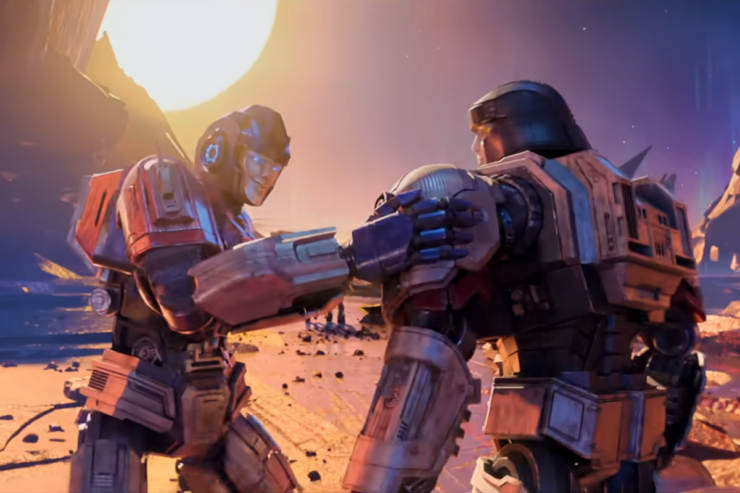Even fans who don’t know the destinies of Orion Pax and D-16, the protagonists of Transformers One, will still cringe at the way they’re treated at the start of the new film, which details the origins of the Autobot/Decepticon conflict. Told since the time of their construction that they’ll never transform, that they’ll never be like the heroic Primes they adore, the duo spend their days working the mines deep within the Transformers’ home planet, Cybertron.
They work under grueling conditions, believing that their labor is necessary for the good of their community, but never seeing the benefits of the work. Worse, they’re constantly reminded of their low position and worthlessness by their boss, the bully Darkwing.
In one of many arguments between the adventurous Pax and the dutiful D-16, Pax asks his pal, “Aren’t you tired of being treated like we’re nothing?”
Those who came to Transformers One expecting a straightforward origin story showing how buddies Orion Pax (Chris Hemsworth) and D-16 (Brian Tyree Henry) eventually become sworn enemies Optimus Prime and Megatron might accept such talk as the sort of “follow your dreams” rhetoric common to kid’s films. But those who pay attention to the film’s depiction of blue-collar work and exploitative ruling classes will see a surprising socialist message in Transformers One, one made all the more timely and relevant by the current state of the animation industry.
Transformers of the World, Unite!
Directed by Josh Cooley and written by Eric Pearson, Andrew Barrer, and Gabriel Ferrari, Transformers One takes place centuries before the mainline Transformers stories. The film shows not just how Optimus Prime and Megatron became adversaries, but also how the heroic Autobots and evil Decepticons came into being.
At the start of the movie, all of the robots live in Iacon City, hidden under the surface of Cybertron. According to their leader Sentinel Prime (John Hamm), the Primes all died fighting off invaders called Quintessons, a victory that left the surface of Cybertron poisoned and drastically depleted the planet’s supply of Energon, their life-giving resource. Thus, the remaining Transformers live highly regimented lives, with many devoted to digging deep into the core, searching for any Energon scraps they can find.
That’s a pretty convoluted setup, but this sort of detailed backstory is what separates the Transformers franchise from its forerunners, the Diaclone and Micro Change mecha lines created by Japanese toy maker Takara Tomy. When Hasbro bought the rights to bring the figures to America, they hired Marvel Comics to create names and backstories that would appeal to Western kids.
So, while the comic series that ran from 1984 to 1991 and the cartoon series that ran from 1981 to 1994 boasted some incredible creators, including writers Steve Gerber and Marv Wolfman, and told stories that people still love today, Transformers came into existence primarily as a commercial to sell toys to children. Given the franchise’s strictly capitalist origins, it’s a bit shocking that Transformers One devotes so much energy to labor politics…
Introduced as a selfish rebel who would rather go on childish adventures than do his job, Orion Pax shows the first glimpses of the leader he’ll become when he dives back into a collapsing mine to save a coworker. The fact that others, including his supervisors, are willing to leave the worker behind shows how little the system thinks of its workers. Others, such as D-16 and Elita-1 (Scarlett Johansson), see hard work and following the rules as the path to success and happiness, but they’re time again undercut by those in charge, who ignore and dismiss their labor and dedication, interested only in increasing their own power.
Scenes involving Sentinel Prime underscore the distinction between the working and ruling classes. After morale drops when Sentinel returns from the surface without the Leadership Matrix—a mythical piece of hardware that secures a robot’s position as the true leader chosen by their god Primus—he declares a day off so that everyone can watch a race through Iacon in order to distract from his failure. The “bread-and-circuses” spirit of the event becomes even more clear when Pax and D-16 sneak in to join, which temporarily gives workers two of their own to root for, before the true elites win the race and put everyone back in their place.
It’s not such a surprise, then, when we get to the big reveal midway through the film… (SPOILERS TO FOLLOW.)
When Pax, D-16, Elita-1, and B-127 (the eventual Bumblebee, voiced by Keegan-Michael Key) travel to the surface to follow newfound clues to the Leadership Matrix, they witness Sentinel Prime at his worst. Instead of endeavoring to find the Matrix himself, Sentinel has been taking the Energon deposits mined by workers and giving them to the Quintessons, who still control Cybertron. By giving the Quintessons the Energon, and performing a show of his deference to them, Sentinel Prime is granted permission to rule over others.
In other words, Sentinel Prime is the kind of manager who forces others to work under terrible conditions, exploiting them and the products of their labor to his own ends; he mollifies the public with pleasing spectacle, and doesn’t even give proper credit to those who did all of the work.
Gee… why does that sound so familiar?
Decepticon-Level Labor Practices
Transformers One arrives on the heels of a host of embarrassing and troubling revelations for the animation industry.
Last year, animators came forward with horror stories about the production of Spider-Man: Across the Spider-Verse, speaking out about mismanagement and grueling hours, all with very little pay. Worse, much of the credit for Across the Spider-Verse, a beautiful and rich movie by any standard, went to writer-producer Phil Lord, one of the people who was allegedly responsible for many of the problems that led to frustration and exhaustion for the artists and techs who worked on the film. (As detailed in the article, Sony executives have disputed the claims about Lord’s management style.)
A recent survey conducted by the Nippon Anime & Film Culture Association found that workers in the anime industry worked long hours for little compensation, despite the fact that anime makes money worldwide. This builds upon an earlier New York Times report that highlighted many anime artists living in poverty while their bosses raked in cash.
Just days ago, IGN ran a story in which an anonymous animator revealed unrealistic expectations in the creation of Pixar’s Inside Out 2, one of the year’s highest grossing films. “I think for a month or two, the animators were working seven days a week,” said IGN’s source “Ridiculous amounts of production workers, just people being tossed into jobs they’d never really done before… It was horrendous.”
Add in complaints that visual effects artists have leveled against Marvel Studios, and it’s clear that those talented artists and technicians who make drawings come to life have been and are still being treated terribly by the studios that employ them. Even as these workers create spectacles of beauty and pure imagination enjoyed by millions, their lives are drudgery.
With the realities of this terrible treatment finally gaining some attention from the media and within fandom, it’s hard not to watch the labor-driven story in Transformers One and think about the conditions of the people who made it. Not just the director and writers, who do deserve praise for their contributions to a very enjoyable film, but also to the teams of animators, effects artists, sound people, and ADR loopers whose names move quickly across the screen in very small font while the audience waits for a post-credit scene, or simply file out of the theater.
The Transformers might be giant robots designed to sell toys, but Transformers One makes the case that these characters deserve dignity and respect for their work. How much more (than meets the eye) is that true of the human beings behind our favorite animated films—artists whose work deserves greater recognition and, even better, financial reward?
Only a heartless Saturday morning villain would do less.











As someone involved in the Animation industry, I really appreciated this write-up. Thanks Joe! Wanted to mention that the Animation Guild is currently negotiating for better conditions for all workers under its umbrella. So hopefully, these ‘Decepticon-level labor practices’ (as you put it) will improve soon.
I never would have given this film a second look. Now it will be on my radar. Thanks much.
Nice. Although, the blue-collar message gets undercut by so many big name actors being in the cast. Were all the professional voice actors sent to another planet? I know Chris Hemsworth is an astounding vocal talent, har har — a regular Mel Blanc, this guy — but how about you let in some talent who aren’t already carrying an Avengers gold card?
Agreed. Even if Peter Cullen and Frank Welker wouldn’t have been right for these younger versions of the characters, they could’ve at least given them cameos (especially Welker, given his assortment of animal noises).